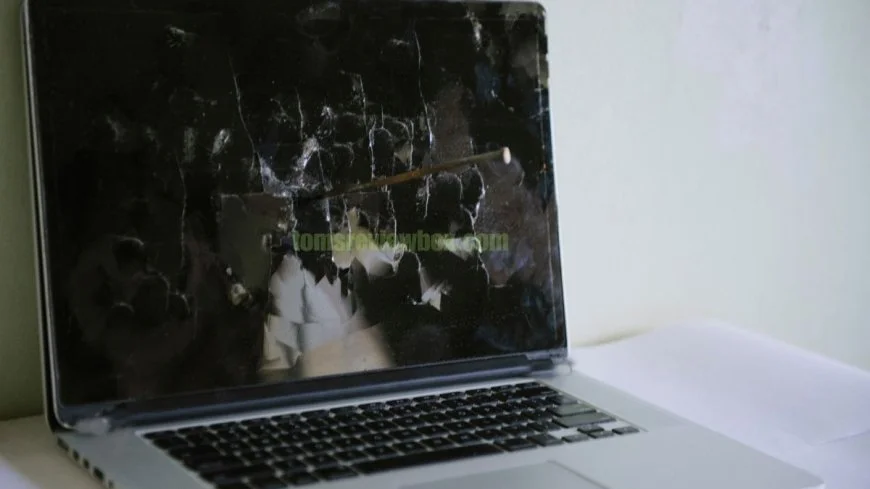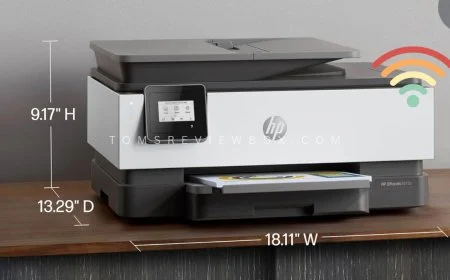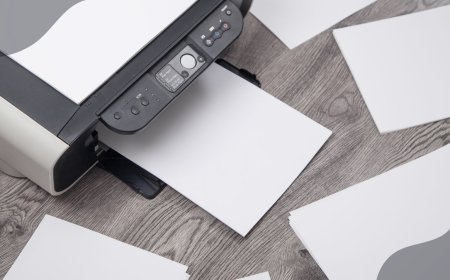How Can I Fix My HP Laptop Screen? – Easy Troubleshooting Guide
Learn how to fix your HP laptop screen with these simple troubleshooting steps. Discover quick solutions for screen issues, whether it's black, flickering, or unresponsive. Read our guide for easy-to-follow fixes.

If your HP laptop screen suddenly stops working or starts malfunctioning, it can be frustrating and concerning. Whether it's flickering, frozen, or entirely black, these issues can disrupt your workflow and cause unnecessary stress. Fortunately, many screen problems have simple fixes that you can do at home before taking your laptop to a technician. In this guide, we’ll walk you through effective methods to troubleshoot and repair your HP laptop screen.
An HP laptop screen issue can range from minor glitches to hardware failures. Common problems include a flickering screen, a black display, or even lines running across the screen. Fixing your HP laptop screen may involve basic troubleshooting like checking connections, updating drivers, or even resetting the display settings. In some cases, a more significant fix, such as replacing the screen or repairing hardware components, might be necessary.
Before diving into complex repairs, let’s start with easy solutions that could save you time and money. Keep reading to learn about the most common HP laptop screen problems and how you can fix them yourself at home. We’ll provide step-by-step instructions, helpful tips, and advice on when it’s time to consult a professional.
Fixing HP Laptop Screen Issues
Figuring Out What's Wrong
When my HP laptop screen acts up, I first need to figure out what's going on. Common problems include a blank screen, a dim display, or visible cracks. Knowing the symptoms helps me decide what to do next.
Here's a quick cheat sheet for common screen problems:
| Problem | Symptoms |
|---|---|
| Blank Screen | No display, but the laptop powers on |
| Dim Display | Low brightness; screen appears faded |
| Cracked Screen | Visible cracks or black spots on the display |
Once I know the problem, I can move on to troubleshooting or repairs.
DIY Screen Repair Basics
If I decide to fix it myself, there are some basics to keep in mind. DIY screen repair can cost less than $100 if I'm willing to buy the parts and tools, which I can often find on eBay (Geeks 2 You).
Before starting, I need the right tools. Typically, I’ll need:
- Screwdriver set (usually Phillips)
- Plastic prying tools
- Anti-static wrist strap
- Replacement screen
Here's the general process:
- Power Off the Laptop: Always turn off the laptop and unplug it.
- Remove the Old Screen: Carefully unscrew and detach the old screen from the frame. Be gentle to avoid damaging any cables.
- Disconnect the Video Cable: This connects the screen to the motherboard. Handle this step delicately.
- Install the New Screen: Connect the new screen’s video cable and secure it.
- Reassemble the Laptop: Screw everything back in and power on the laptop to check if the screen works.
If the brightness issue sticks around, it might be a problem with the screen inverter or backlight lamp, which would need replacing (Mobile PC Medics).
By following these steps, I can tackle screen repairs on my HP laptop and save a lot of money compared to professional repair costs, which can range from $200 to $300 (Geeks 2 You).
Common Screen Problems
Dealing with screen issues on my HP laptop can be a real headache. Here are some common problems I've run into and the fixes that have worked for me.
Blank Screen Solutions
When my laptop screen goes blank but the device is still on, here's what I do. First, I unplug the laptop and take out the battery. Then, I hold down the power button for about a minute before restarting. This simple reset often does the trick.
If the screen stays blank, I back up my data first. Then, I do a hard reset: unplug the power, remove the battery, hold the power button for 20 seconds, and reconnect the power. If it's still blank, it might be a motherboard issue, and that's when I call in the pros (Onsitego).
Dim Display Troubleshooting
A dim screen can be a real pain. It might be the screen inverter or backlight lamp acting up. Sometimes, just tweaking the brightness settings or restarting the laptop fixes it. If not, it's probably the inverter board or backlight bulb, which usually means a trip to the repair shop.
Dealing with Cracks
Cracks in my laptop screen usually come from drops or pressure. They can really mess up the functionality. Screen replacements can be pricey, sometimes up to Rs. 15,000. To avoid this hit to my wallet, I think about getting a protection plan for future mishaps.
Fixing these common screen issues helps keep my laptop running smoothly and saves me time and money in the long run.
Advanced Screen Issues
When my HP laptop screen acts up, it's often a sign of deeper problems that need a closer look. Two usual suspects are faulty motherboards and issues with the inverter or backlight.
Faulty Motherboard Signs
A dodgy motherboard can mess with my laptop screen in various ways. If my laptop refuses to turn on, it could be due to a bad AC adapter or a busted DC power jack. I might try wiggling the plug in the jack to see if that helps, but if my laptop still won't boot, the DC jack might need replacing, or it could be a motherboard issue.
Here are some signs that my motherboard might be the problem:
| Signs of a Faulty Motherboard | Description |
|---|---|
| Laptop Won't Power On | The laptop shows no signs of life. |
| Strange or Garbled Images | Weird visuals on the screen might not just be a display issue. Testing with an external monitor can help figure out if the motherboard is the culprit. |
| Random Crashes or Freezes | Frequent crashes or freezes can also point to motherboard problems. |
If I think the motherboard is at fault, checking the memory modules is a good idea since memory issues can also cause screen problems.
Inverter and Backlight Problems
Another common headache for my HP laptop screen is related to the inverter or backlight. If my screen is dim or completely dark, it might be due to a failure in the screen inverter or the backlight lamp. These parts are essential for lighting up the display.
Here are some signs of inverter and backlight issues:
| Inverter and Backlight Issues | Description |
|---|---|
| Dim Screen | If the screen is hard to see even in good lighting, the inverter might need replacing. |
| Flickering Display | A flickering screen can indicate an inverter problem. |
| Complete Darkness | If the laptop is on but the screen stays dark, the backlight lamp might be the issue. |
If my screen light fails, replacing the inverter or backlight lamp might fix the problem. Knowing these advanced screen issues can help me troubleshoot and fix my HP laptop screen effectively.
External Monitor Testing
Testing with an external monitor is a simple way to figure out if your HP laptop screen is the problem. Here's how to do it right.
Using an External Monitor
First, you need to connect your laptop to an external monitor. You can use an HDMI, VGA, or DisplayPort cable, depending on what ports you have. Follow these steps:
- Turn off your laptop.
- Connect the external monitor to your laptop with the right cable.
- Power on the external monitor.
- Turn on your laptop.
- Switch display modes if needed. Usually, you press the
Fnkey and one of the function keys (likeF4orF5) with a monitor icon.
Once connected, you should see your laptop's display on the external monitor.
Interpreting External Monitor Results
After connecting the external monitor, observe the display. The results will tell you a lot about your laptop's screen condition.
| Outcome | What It Means |
|---|---|
| Image is fine on the external monitor | The problem is likely with your laptop's screen or its connections. It could be a faulty LCD or a loose connection. |
| Strange or garbled images on the external monitor | The issue might be with your laptop’s graphics card or motherboard. |
| Vertical lines (multi-colored or single-colored) on the laptop screen | This could mean hardware failure or damage. Try unplugging the laptop, holding the power button for 30 seconds, and then restarting. If the lines are still there, the LCD screen probably needs replacing. |
Using an external monitor helps you figure out if the issue is with your HP laptop or just the screen. This method is quick and can save you time and effort in diagnosing the problem correctly.
Professional Help vs. DIY
When my HP laptop screen acts up, I always find myself torn between calling in the pros or rolling up my sleeves for a DIY fix. Each choice has its perks and pitfalls, especially when it comes to cost and results.
Cost Comparison
Money talks, right? Knowing the financial hit of each option helps me decide. Professional repairs can be pricey, but they often come with peace of mind. Here's a quick look at the costs:
| Repair Method | Estimated Cost |
|---|---|
| Professional | $200 - $300 |
| DIY | Less than $100 |
Fixing it myself could save me a bundle, especially if I snag the parts from places like eBay. But, I gotta remember that unexpected issues might pop up, adding to the cost.
Pros and Cons of Professional Repair
Choosing between DIY and a pro means weighing the good and the bad of each.
Pros of Professional Repair
- Expertise: Pros know their stuff and can diagnose and fix issues spot-on.
- Preventative Advice: Services like Geeks 2 You offer tips to dodge future problems and viruses.
- Warranty: Many repairs come with a warranty, giving me peace of mind if something goes wrong later.
Cons of Professional Repair
- Cost: Going pro can be way more expensive than DIY.
- Turnaround Time: I might have to wait longer for the repair, especially if the shop's busy.
Pros of DIY Repair
- Cost-Effective: DIY repairs can be done for less than $100 if I buy the parts myself.
- Learning Experience: I get hands-on experience and learn more about my laptop.
Cons of DIY Repair
- Risk of Damage: If I mess up, I could cause more damage, leading to higher costs.
- Lack of Support: Without a pro's guidance, troubleshooting can be tough if unexpected issues come up.
By weighing the costs and the pros and cons of each option, I can make a smarter choice on how to fix my HP laptop screen.
Final Thoughts – How Can I Fix My HP Laptop Screen?
Fixing your HP laptop screen may seem like a daunting task, but many issues can be resolved with basic troubleshooting methods. Whether it’s a flickering screen, lines across the display, or a complete black-out, trying out the solutions mentioned in this guide can often resolve the problem without professional help. However, if the issue persists, don’t hesitate to consult an expert to prevent further damage to your device.
FAQs About Fixing HP Laptop Screen
Q: Why is my HP laptop screen black but the laptop is still on?
A: This is often caused by display issues, such as loose connections or faulty hardware. First, try restarting your laptop or connecting it to an external monitor to check if the screen itself is faulty. If the external monitor works, you may need to fix or replace the laptop screen.
Q: How can I fix flickering on my HP laptop screen?
A: Screen flickering can usually be fixed by updating your graphics driver, checking for incompatible apps, or adjusting your refresh rate. If these steps don’t work, the problem may lie with your laptop's hardware.
Q: What should I do if my HP laptop screen has lines running across it?
A: Lines on your screen can be a sign of a damaged display or a graphics card issue. Start by updating your drivers. If the lines persist, you may need to consider hardware repair or screen replacement.
Q: Can I repair my HP laptop screen myself?
A: Yes, minor issues such as loose connections or outdated drivers can be fixed at home. However, for physical damage or severe screen issues, it’s recommended to seek professional help to avoid further damage.
Q: How much does it cost to repair an HP laptop screen?
A: The cost can vary depending on the model and type of damage. A screen replacement can range from $100 to $300, depending on whether it's done by HP or a third-party repair service.
Q: How can I prevent screen issues on my HP laptop?
A: Regularly updating drivers, avoiding physical damage, and using proper screen protection (like a screen guard) can help prevent most screen issues. Additionally, be mindful of overloading your laptop’s system, which can lead to overheating and screen malfunctions.
What's Your Reaction?







































![MacBook Pro M5: All the features and specs you need to know [LEAKS REVEALED]](https://tomsreviewbox.com/uploads/images/202502/image_430x256_67bd6d7cd7562.jpg)


























